Before I had my baby, I carefully arranged the nursery with cute clothes sorted by size, sure that my baby would be the best-dressed in town. My baby lived in onesies and sleepers for weeks, so let us be real. I kept reaching for the same easy-to-wash basics over and over again, leaving those cute outfits with tiny buttons and complicated fasteners unworn. I quickly learned that when it comes to babies, function always comes before fashion.
.jpeg)
The question "how many" took up all of my shopping before the baby. Here's my realistic number after three months of working: 8 to 10 onesies, 6 to 8 sleepers, 4 to 6 pairs of pants, and a lot more burp cloths than you think you need. Newborns need to change their clothes several times a day because they spit up, have blowouts, and are generally messy. Having enough basics to last until laundry day stops you from having to wash everything in a panic at night when it is all dirty.
Once I learned how to keep a newborn's temperature stable, layering became an art form. Most babies need one more layer than what you are wearing, but some babies need more. I learned to feel the back of my baby's neck to see if it was warm. Hands and feet are often cool and not good signs. Onesies under sleepers made it easy to change layers, and sleep sacks were safer than loose blankets for keeping warm while sleeping.
I did not think the fabric choices would matter as much for newborns with sensitive skin. Soft cotton was the most comfortable and breathable, but synthetic materials sometimes made me feel bad or too hot. I stayed away from clothes with rough seams, scratchy tags, or decorative elements that could irritate sensitive skin. Washing everything in a gentle, fragrance-free detergent before using it got rid of chemicals from the factory and made the fabrics softer.
Size considerations needed flexible thinking because you can not predict how fast a newborn will grow. My baby was 7 pounds and wore newborn size for weeks, while my friends' bigger babies went straight to 0-3 months. I learned to look at weight ranges instead of age labels, and I bought clothes in a range of sizes. Some babies do not even wear newborn sizes, so those little outfits are just cute keepsakes.
The way I do laundry changed from folding things perfectly to a more efficient survival mode. I set aside certain baby laundry baskets and a schedule for washing them so that they would not get too full. Treatment for stains started right away because the longer they sit, the harder they are to get rid of. I always had stain remover spray on hand, and I found that enzyme cleaners that are safe for babies work great on protein-based stains from spit-up and diaper accidents.
Useful features helped me keep my cool and save time during those awkward first few weeks. When changing a squirmy baby in low light, snap or zip closures are better than tiny buttons. Onesies with envelope shoulders let you pull them down over the baby's shoulders instead of pulling the mess over their head when they blow out. Footie pajamas with fold-over hand covers stop scratching without needing separate mittens that keep falling off.
Frequently Asked Questions
Q: How many newborn clothes do I actually need?
A: Plan for 8-10 onesies, 6-8 sleepers, 4-6 pants, and plenty of burp cloths. Buy basics rather than fancy outfits initially.
Q: Should I buy newborn or 0-3 month sizes?
A: Buy both! Babies vary greatly in size, and some skip newborn sizes while others wear them for weeks.
Q: What fabrics are best for newborn skin?
A: Soft, breathable cotton is ideal. Avoid rough seams, scratchy materials, and synthetic fabrics that don't breathe well.
Q: How often should I do baby laundry?
A: Every 2-3 days typically, depending on how many clothes you have. Newborns generate lots of laundry!
Q: What laundry detergent is safe for babies?
A: Use gentle, fragrance-free detergents designed for sensitive skin. Avoid fabric softeners which can reduce absorbency.
Q: How should I layer baby clothes?
A: Generally one more layer than you're wearing. Check baby's neck for warmth and adjust as needed.
Q: Are sleep sacks better than blankets?
A: Yes, sleep sacks provide warmth without suffocation risk. They're safer than loose blankets in the crib.
Q: How do I remove stains from baby clothes?
A: Treat stains immediately with baby-safe stain remover. Enzyme cleaners work well on protein-based stains.
Q: What features make baby clothes more practical?
A: Look for envelope shoulders, easy closures (snaps over buttons), and fold-over hand covers to prevent scratching.
Q: When do babies outgrow newborn clothes?
A: Varies widely! Some babies wear newborn size for weeks, others skip it entirely. Focus on weight ranges, not age labels.
SEO Keywords: newborn clothing guide, baby laundry tips, how many onesies
Comments
Post a Comment